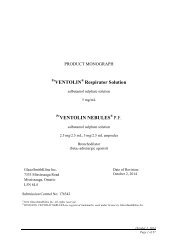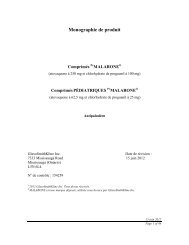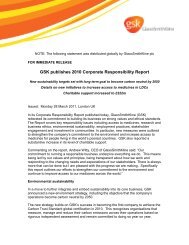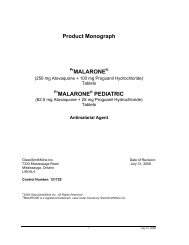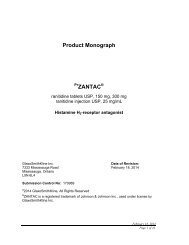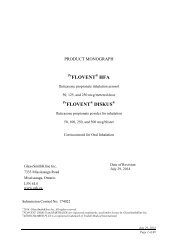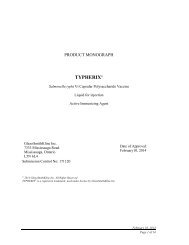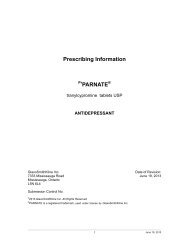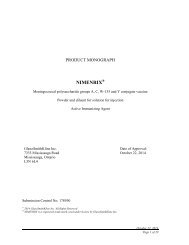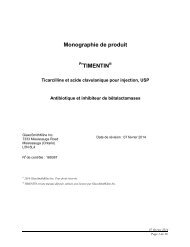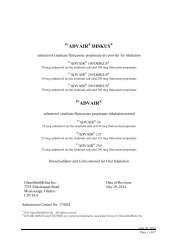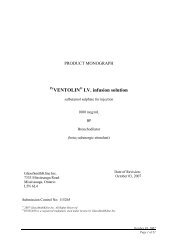PRODUCT MONOGRAPH IMITREX DF IMITREX ... - GlaxoSmithKline
PRODUCT MONOGRAPH IMITREX DF IMITREX ... - GlaxoSmithKline
PRODUCT MONOGRAPH IMITREX DF IMITREX ... - GlaxoSmithKline
Create successful ePaper yourself
Turn your PDF publications into a flip-book with our unique Google optimized e-Paper software.
gram of fetus was detected. The blood levels at this dose were 172 - 269 ng/mL. At thematernally toxic dose of 50 mg/kg in rabbits, blood levels reached 3180-6750 ng/mL.Organogenesis studies conducted using intravenous doses of up to 12.5 mg/kg/day in ratsrevealed fused ribs at a dose of 2.5 mg/kg/day and rudimentary tail and dilatation of therenal pelvis at a dose of 12.5 mg/kg/day. The treatment had no adverse effects on eitherthe dams or the fetuses and the malformations were considered unrelated to treatmentsince they are known to occur spontaneously in the control groups of the rat strainemployed.Rabbits were also studied using intravenous doses of up to 8.0 mg/kg/day which revealedno teratological response. However, in the first study a statistically significant doserelatedincreasing trend in prenatal mortality was seen due to apparent maternal toxicity.In the second study, using intravenous doses up to 2.0 mg/kg/day, no maternal toxicity orincreased prenatal mortality were observed.Fertility studies conducted in rats with oral doses of up to 500 mg/kg/day andsubcutaneous doses of up to 60 mg/kg/day indicated that there were no adverse effectsupon the reproductive performance of the treated, parental generation, or upon the growthand development of two successive untreated generations.In peri- and postnatal studies conducted in rats given oral doses of up to 1000 mg/kg/dayand subcutaneous doses of up to 81 mg/kg/day, no toxicological adverse effects that mayhave been relevant to the peri- and postnatal development of their offspring were seen.However, oral administration of 1000 mg/kg/day during periods of pregnancy andlactation resulted in a decrease in maternal and fetal body weight.A comprehensive evaluation of the effects of sumatriptan on reproduction indicates thatthe compound is devoid of teratogenic potential in the rat. In addition, there were noadverse effects on fertility or postnatal development. In rabbit oral reproduction studies,there were increased incidences of variations in cervico-thoracic blood vesselconfiguration in the fetuses, but these were only seen at maternally toxic doses in whichblood levels were in excess of 50 times those seen after therapeutic doses in humans. Adirect association with sumatriptan treatment is considered unlikely but cannot beexcluded. The relevance to humans is unknown.Local ToleranceThe subcutaneous and intramuscular administration of 1 mL of a solution of sumatriptan(50 mg/mL) to rabbits produced no overt signs of irritancy and caused only slightnecrotic changes in the deepest layers of the subcuticular muscle. While thesubcutaneous lesions healed in a rapid and uncomplicated manner, the intramuscularlesions were moderately slow to heal.At a lower concentration (2.5 mg/mL) no signs of subcutaneous or intramuscularirritancy were apparent.October 21, 2014Page 38 of 58



